Australian Commercial Law
VerifiedAdded on 2023/01/23
|9
|2487
|41
AI Summary
This document discusses the issues, rules, and applications related to Australian Commercial Law. It covers topics such as valid offers, invitations to treat, enforceability of promises, elements of a valid contract, and remedies for breach of contract. The document provides analysis and conclusions for each scenario.
Contribute Materials
Your contribution can guide someone’s learning journey. Share your
documents today.
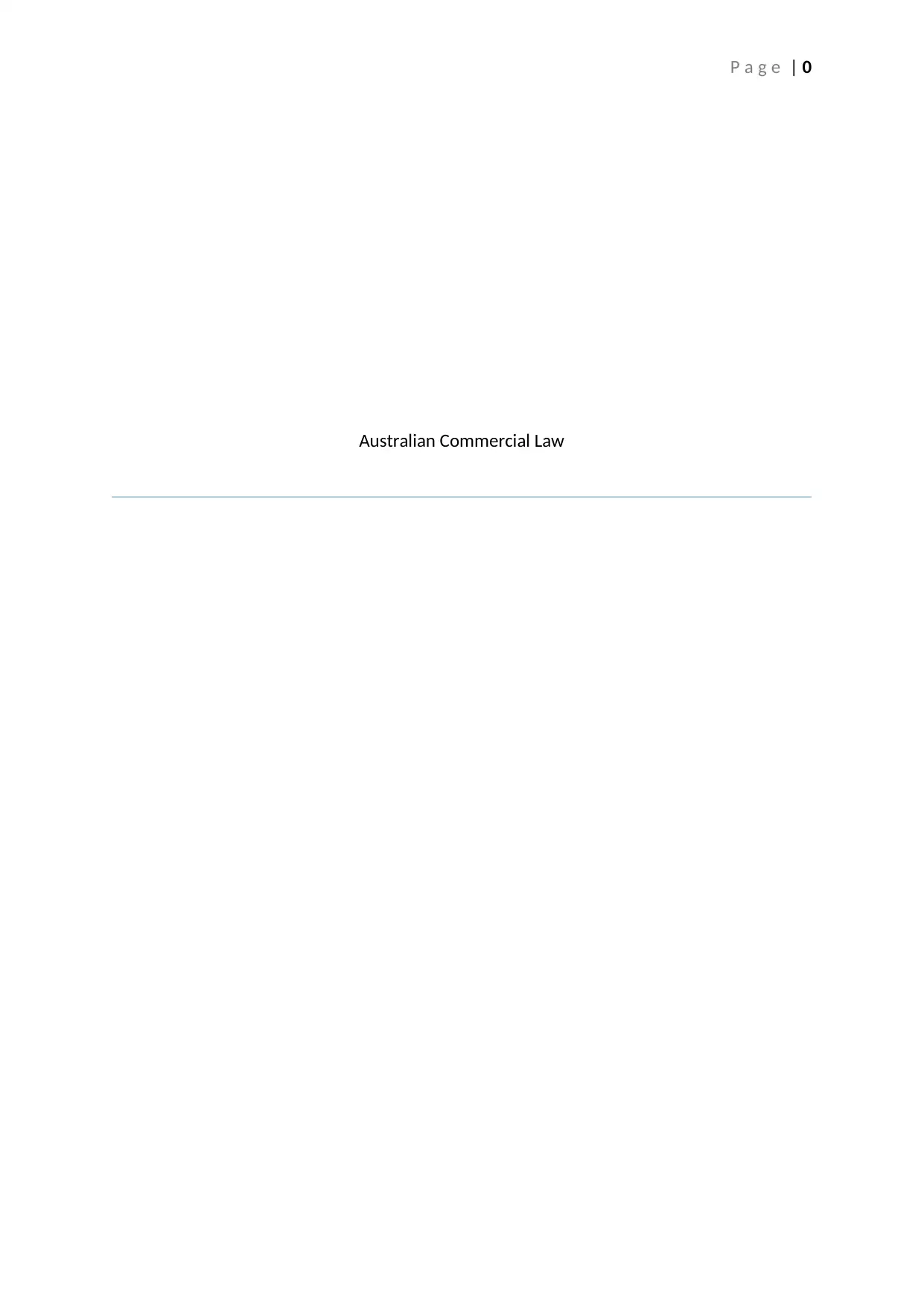
P a g e | 0
Australian Commercial Law
Australian Commercial Law
Secure Best Marks with AI Grader
Need help grading? Try our AI Grader for instant feedback on your assignments.
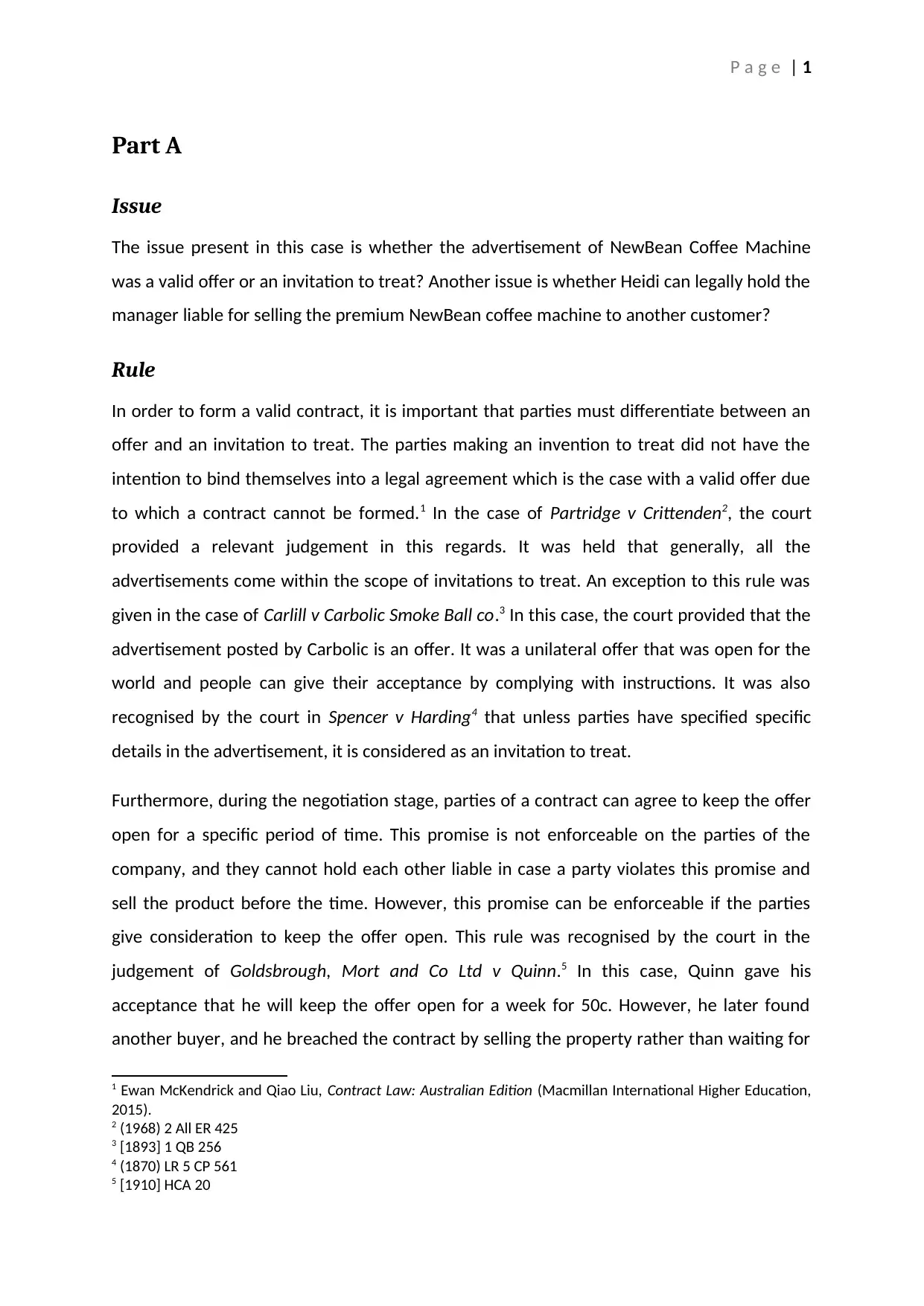
P a g e | 1
Part A
Issue
The issue present in this case is whether the advertisement of NewBean Coffee Machine
was a valid offer or an invitation to treat? Another issue is whether Heidi can legally hold the
manager liable for selling the premium NewBean coffee machine to another customer?
Rule
In order to form a valid contract, it is important that parties must differentiate between an
offer and an invitation to treat. The parties making an invention to treat did not have the
intention to bind themselves into a legal agreement which is the case with a valid offer due
to which a contract cannot be formed.1 In the case of Partridge v Crittenden2, the court
provided a relevant judgement in this regards. It was held that generally, all the
advertisements come within the scope of invitations to treat. An exception to this rule was
given in the case of Carlill v Carbolic Smoke Ball co.3 In this case, the court provided that the
advertisement posted by Carbolic is an offer. It was a unilateral offer that was open for the
world and people can give their acceptance by complying with instructions. It was also
recognised by the court in Spencer v Harding4 that unless parties have specified specific
details in the advertisement, it is considered as an invitation to treat.
Furthermore, during the negotiation stage, parties of a contract can agree to keep the offer
open for a specific period of time. This promise is not enforceable on the parties of the
company, and they cannot hold each other liable in case a party violates this promise and
sell the product before the time. However, this promise can be enforceable if the parties
give consideration to keep the offer open. This rule was recognised by the court in the
judgement of Goldsbrough, Mort and Co Ltd v Quinn.5 In this case, Quinn gave his
acceptance that he will keep the offer open for a week for 50c. However, he later found
another buyer, and he breached the contract by selling the property rather than waiting for
1 Ewan McKendrick and Qiao Liu, Contract Law: Australian Edition (Macmillan International Higher Education,
2015).
2 (1968) 2 All ER 425
3 [1893] 1 QB 256
4 (1870) LR 5 CP 561
5 [1910] HCA 20
Part A
Issue
The issue present in this case is whether the advertisement of NewBean Coffee Machine
was a valid offer or an invitation to treat? Another issue is whether Heidi can legally hold the
manager liable for selling the premium NewBean coffee machine to another customer?
Rule
In order to form a valid contract, it is important that parties must differentiate between an
offer and an invitation to treat. The parties making an invention to treat did not have the
intention to bind themselves into a legal agreement which is the case with a valid offer due
to which a contract cannot be formed.1 In the case of Partridge v Crittenden2, the court
provided a relevant judgement in this regards. It was held that generally, all the
advertisements come within the scope of invitations to treat. An exception to this rule was
given in the case of Carlill v Carbolic Smoke Ball co.3 In this case, the court provided that the
advertisement posted by Carbolic is an offer. It was a unilateral offer that was open for the
world and people can give their acceptance by complying with instructions. It was also
recognised by the court in Spencer v Harding4 that unless parties have specified specific
details in the advertisement, it is considered as an invitation to treat.
Furthermore, during the negotiation stage, parties of a contract can agree to keep the offer
open for a specific period of time. This promise is not enforceable on the parties of the
company, and they cannot hold each other liable in case a party violates this promise and
sell the product before the time. However, this promise can be enforceable if the parties
give consideration to keep the offer open. This rule was recognised by the court in the
judgement of Goldsbrough, Mort and Co Ltd v Quinn.5 In this case, Quinn gave his
acceptance that he will keep the offer open for a week for 50c. However, he later found
another buyer, and he breached the contract by selling the property rather than waiting for
1 Ewan McKendrick and Qiao Liu, Contract Law: Australian Edition (Macmillan International Higher Education,
2015).
2 (1968) 2 All ER 425
3 [1893] 1 QB 256
4 (1870) LR 5 CP 561
5 [1910] HCA 20
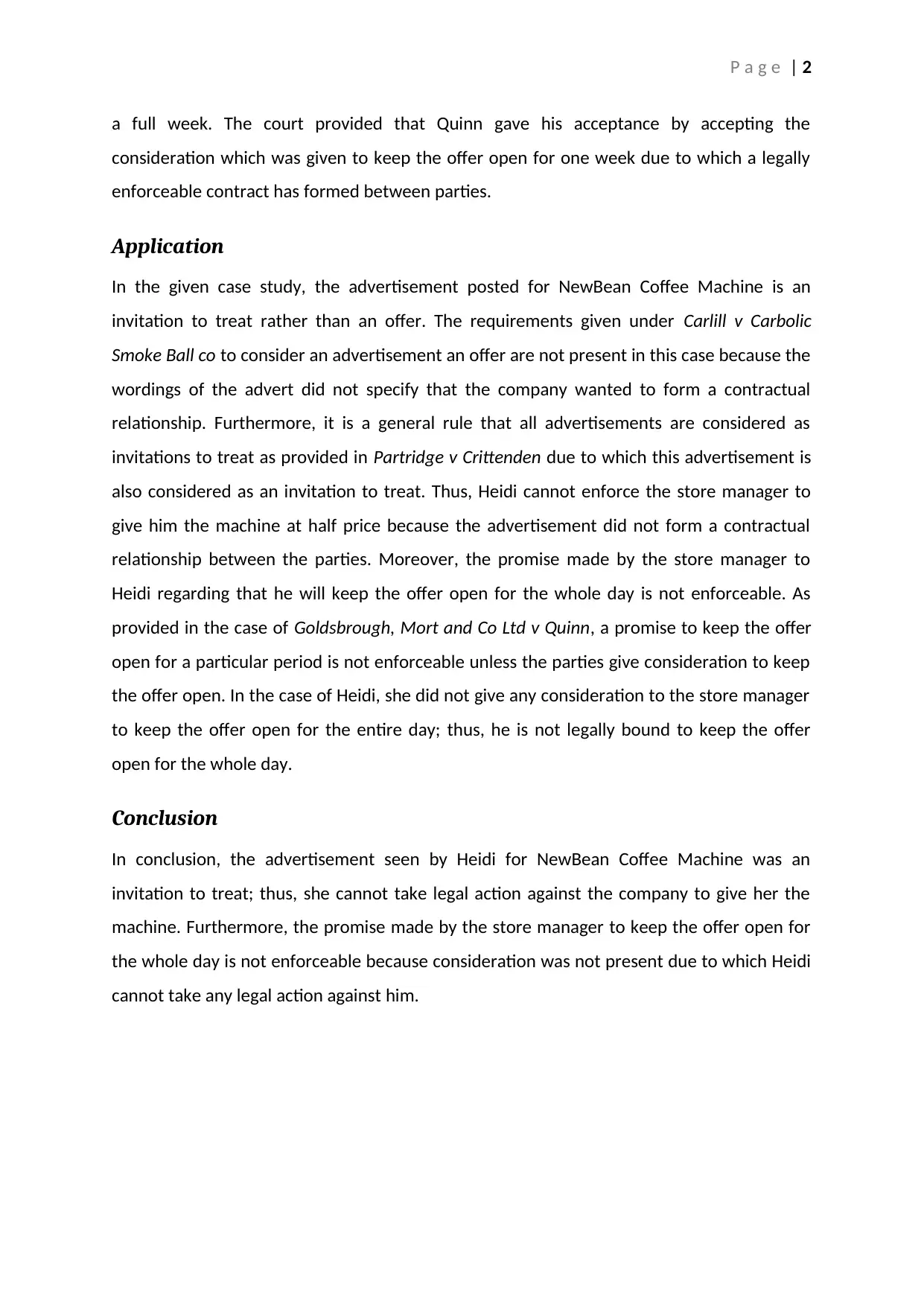
P a g e | 2
a full week. The court provided that Quinn gave his acceptance by accepting the
consideration which was given to keep the offer open for one week due to which a legally
enforceable contract has formed between parties.
Application
In the given case study, the advertisement posted for NewBean Coffee Machine is an
invitation to treat rather than an offer. The requirements given under Carlill v Carbolic
Smoke Ball co to consider an advertisement an offer are not present in this case because the
wordings of the advert did not specify that the company wanted to form a contractual
relationship. Furthermore, it is a general rule that all advertisements are considered as
invitations to treat as provided in Partridge v Crittenden due to which this advertisement is
also considered as an invitation to treat. Thus, Heidi cannot enforce the store manager to
give him the machine at half price because the advertisement did not form a contractual
relationship between the parties. Moreover, the promise made by the store manager to
Heidi regarding that he will keep the offer open for the whole day is not enforceable. As
provided in the case of Goldsbrough, Mort and Co Ltd v Quinn, a promise to keep the offer
open for a particular period is not enforceable unless the parties give consideration to keep
the offer open. In the case of Heidi, she did not give any consideration to the store manager
to keep the offer open for the entire day; thus, he is not legally bound to keep the offer
open for the whole day.
Conclusion
In conclusion, the advertisement seen by Heidi for NewBean Coffee Machine was an
invitation to treat; thus, she cannot take legal action against the company to give her the
machine. Furthermore, the promise made by the store manager to keep the offer open for
the whole day is not enforceable because consideration was not present due to which Heidi
cannot take any legal action against him.
a full week. The court provided that Quinn gave his acceptance by accepting the
consideration which was given to keep the offer open for one week due to which a legally
enforceable contract has formed between parties.
Application
In the given case study, the advertisement posted for NewBean Coffee Machine is an
invitation to treat rather than an offer. The requirements given under Carlill v Carbolic
Smoke Ball co to consider an advertisement an offer are not present in this case because the
wordings of the advert did not specify that the company wanted to form a contractual
relationship. Furthermore, it is a general rule that all advertisements are considered as
invitations to treat as provided in Partridge v Crittenden due to which this advertisement is
also considered as an invitation to treat. Thus, Heidi cannot enforce the store manager to
give him the machine at half price because the advertisement did not form a contractual
relationship between the parties. Moreover, the promise made by the store manager to
Heidi regarding that he will keep the offer open for the whole day is not enforceable. As
provided in the case of Goldsbrough, Mort and Co Ltd v Quinn, a promise to keep the offer
open for a particular period is not enforceable unless the parties give consideration to keep
the offer open. In the case of Heidi, she did not give any consideration to the store manager
to keep the offer open for the entire day; thus, he is not legally bound to keep the offer
open for the whole day.
Conclusion
In conclusion, the advertisement seen by Heidi for NewBean Coffee Machine was an
invitation to treat; thus, she cannot take legal action against the company to give her the
machine. Furthermore, the promise made by the store manager to keep the offer open for
the whole day is not enforceable because consideration was not present due to which Heidi
cannot take any legal action against him.
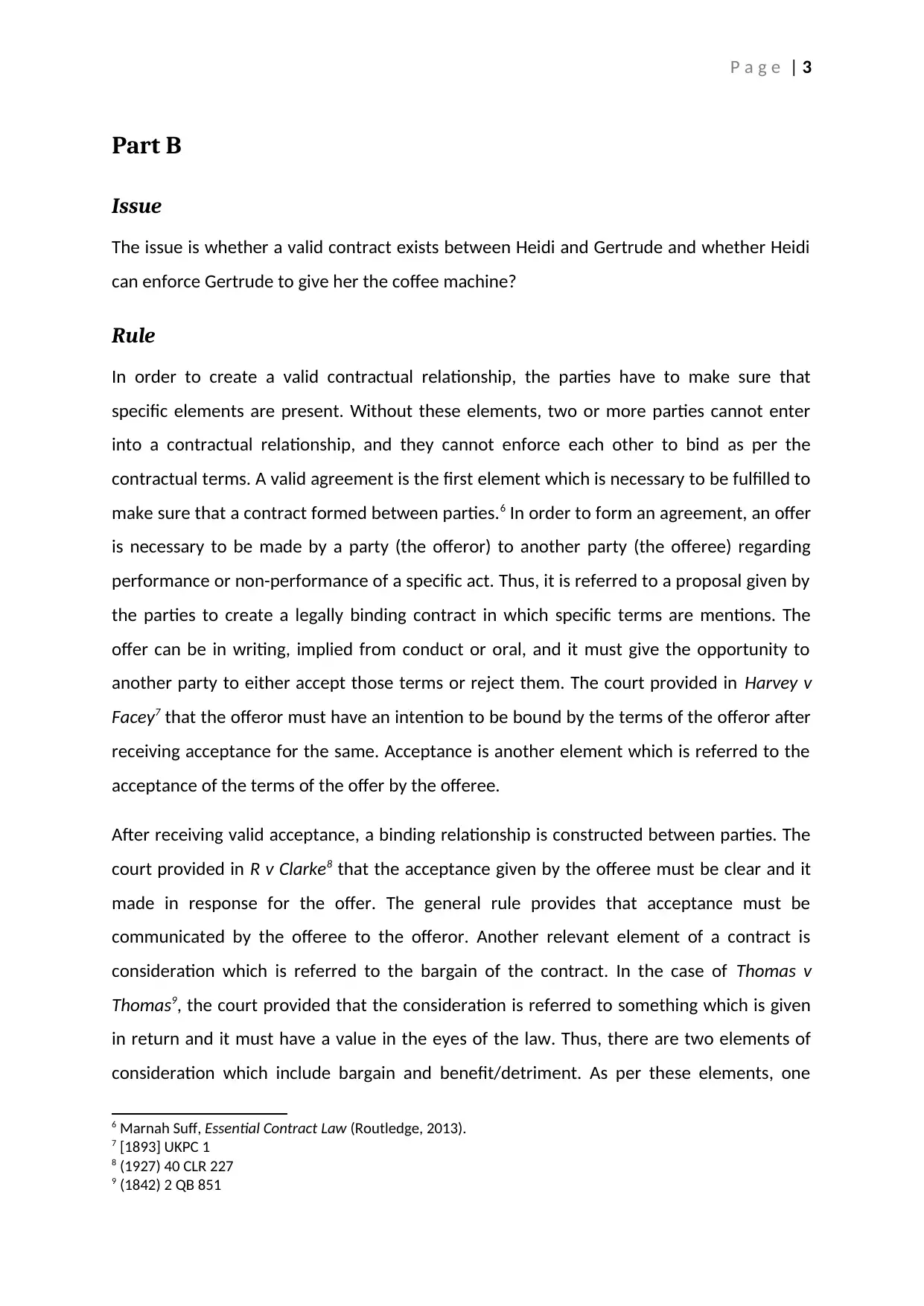
P a g e | 3
Part B
Issue
The issue is whether a valid contract exists between Heidi and Gertrude and whether Heidi
can enforce Gertrude to give her the coffee machine?
Rule
In order to create a valid contractual relationship, the parties have to make sure that
specific elements are present. Without these elements, two or more parties cannot enter
into a contractual relationship, and they cannot enforce each other to bind as per the
contractual terms. A valid agreement is the first element which is necessary to be fulfilled to
make sure that a contract formed between parties.6 In order to form an agreement, an offer
is necessary to be made by a party (the offeror) to another party (the offeree) regarding
performance or non-performance of a specific act. Thus, it is referred to a proposal given by
the parties to create a legally binding contract in which specific terms are mentions. The
offer can be in writing, implied from conduct or oral, and it must give the opportunity to
another party to either accept those terms or reject them. The court provided in Harvey v
Facey7 that the offeror must have an intention to be bound by the terms of the offeror after
receiving acceptance for the same. Acceptance is another element which is referred to the
acceptance of the terms of the offer by the offeree.
After receiving valid acceptance, a binding relationship is constructed between parties. The
court provided in R v Clarke8 that the acceptance given by the offeree must be clear and it
made in response for the offer. The general rule provides that acceptance must be
communicated by the offeree to the offeror. Another relevant element of a contract is
consideration which is referred to the bargain of the contract. In the case of Thomas v
Thomas9, the court provided that the consideration is referred to something which is given
in return and it must have a value in the eyes of the law. Thus, there are two elements of
consideration which include bargain and benefit/detriment. As per these elements, one
6 Marnah Suff, Essential Contract Law (Routledge, 2013).
7 [1893] UKPC 1
8 (1927) 40 CLR 227
9 (1842) 2 QB 851
Part B
Issue
The issue is whether a valid contract exists between Heidi and Gertrude and whether Heidi
can enforce Gertrude to give her the coffee machine?
Rule
In order to create a valid contractual relationship, the parties have to make sure that
specific elements are present. Without these elements, two or more parties cannot enter
into a contractual relationship, and they cannot enforce each other to bind as per the
contractual terms. A valid agreement is the first element which is necessary to be fulfilled to
make sure that a contract formed between parties.6 In order to form an agreement, an offer
is necessary to be made by a party (the offeror) to another party (the offeree) regarding
performance or non-performance of a specific act. Thus, it is referred to a proposal given by
the parties to create a legally binding contract in which specific terms are mentions. The
offer can be in writing, implied from conduct or oral, and it must give the opportunity to
another party to either accept those terms or reject them. The court provided in Harvey v
Facey7 that the offeror must have an intention to be bound by the terms of the offeror after
receiving acceptance for the same. Acceptance is another element which is referred to the
acceptance of the terms of the offer by the offeree.
After receiving valid acceptance, a binding relationship is constructed between parties. The
court provided in R v Clarke8 that the acceptance given by the offeree must be clear and it
made in response for the offer. The general rule provides that acceptance must be
communicated by the offeree to the offeror. Another relevant element of a contract is
consideration which is referred to the bargain of the contract. In the case of Thomas v
Thomas9, the court provided that the consideration is referred to something which is given
in return and it must have a value in the eyes of the law. Thus, there are two elements of
consideration which include bargain and benefit/detriment. As per these elements, one
6 Marnah Suff, Essential Contract Law (Routledge, 2013).
7 [1893] UKPC 1
8 (1927) 40 CLR 227
9 (1842) 2 QB 851
Secure Best Marks with AI Grader
Need help grading? Try our AI Grader for instant feedback on your assignments.
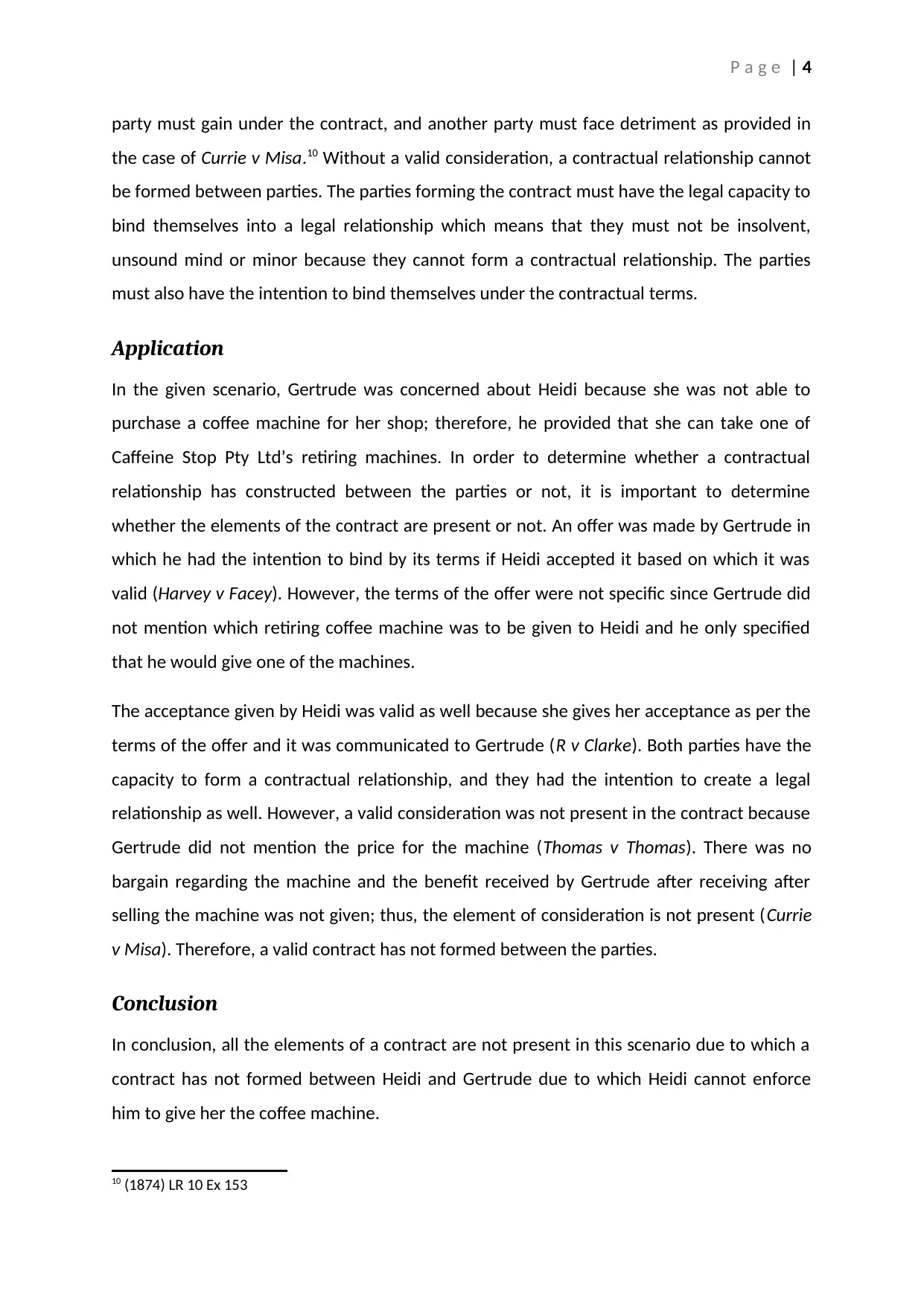
P a g e | 4
party must gain under the contract, and another party must face detriment as provided in
the case of Currie v Misa.10 Without a valid consideration, a contractual relationship cannot
be formed between parties. The parties forming the contract must have the legal capacity to
bind themselves into a legal relationship which means that they must not be insolvent,
unsound mind or minor because they cannot form a contractual relationship. The parties
must also have the intention to bind themselves under the contractual terms.
Application
In the given scenario, Gertrude was concerned about Heidi because she was not able to
purchase a coffee machine for her shop; therefore, he provided that she can take one of
Caffeine Stop Pty Ltd’s retiring machines. In order to determine whether a contractual
relationship has constructed between the parties or not, it is important to determine
whether the elements of the contract are present or not. An offer was made by Gertrude in
which he had the intention to bind by its terms if Heidi accepted it based on which it was
valid (Harvey v Facey). However, the terms of the offer were not specific since Gertrude did
not mention which retiring coffee machine was to be given to Heidi and he only specified
that he would give one of the machines.
The acceptance given by Heidi was valid as well because she gives her acceptance as per the
terms of the offer and it was communicated to Gertrude (R v Clarke). Both parties have the
capacity to form a contractual relationship, and they had the intention to create a legal
relationship as well. However, a valid consideration was not present in the contract because
Gertrude did not mention the price for the machine (Thomas v Thomas). There was no
bargain regarding the machine and the benefit received by Gertrude after receiving after
selling the machine was not given; thus, the element of consideration is not present (Currie
v Misa). Therefore, a valid contract has not formed between the parties.
Conclusion
In conclusion, all the elements of a contract are not present in this scenario due to which a
contract has not formed between Heidi and Gertrude due to which Heidi cannot enforce
him to give her the coffee machine.
10 (1874) LR 10 Ex 153
party must gain under the contract, and another party must face detriment as provided in
the case of Currie v Misa.10 Without a valid consideration, a contractual relationship cannot
be formed between parties. The parties forming the contract must have the legal capacity to
bind themselves into a legal relationship which means that they must not be insolvent,
unsound mind or minor because they cannot form a contractual relationship. The parties
must also have the intention to bind themselves under the contractual terms.
Application
In the given scenario, Gertrude was concerned about Heidi because she was not able to
purchase a coffee machine for her shop; therefore, he provided that she can take one of
Caffeine Stop Pty Ltd’s retiring machines. In order to determine whether a contractual
relationship has constructed between the parties or not, it is important to determine
whether the elements of the contract are present or not. An offer was made by Gertrude in
which he had the intention to bind by its terms if Heidi accepted it based on which it was
valid (Harvey v Facey). However, the terms of the offer were not specific since Gertrude did
not mention which retiring coffee machine was to be given to Heidi and he only specified
that he would give one of the machines.
The acceptance given by Heidi was valid as well because she gives her acceptance as per the
terms of the offer and it was communicated to Gertrude (R v Clarke). Both parties have the
capacity to form a contractual relationship, and they had the intention to create a legal
relationship as well. However, a valid consideration was not present in the contract because
Gertrude did not mention the price for the machine (Thomas v Thomas). There was no
bargain regarding the machine and the benefit received by Gertrude after receiving after
selling the machine was not given; thus, the element of consideration is not present (Currie
v Misa). Therefore, a valid contract has not formed between the parties.
Conclusion
In conclusion, all the elements of a contract are not present in this scenario due to which a
contract has not formed between Heidi and Gertrude due to which Heidi cannot enforce
him to give her the coffee machine.
10 (1874) LR 10 Ex 153

P a g e | 5
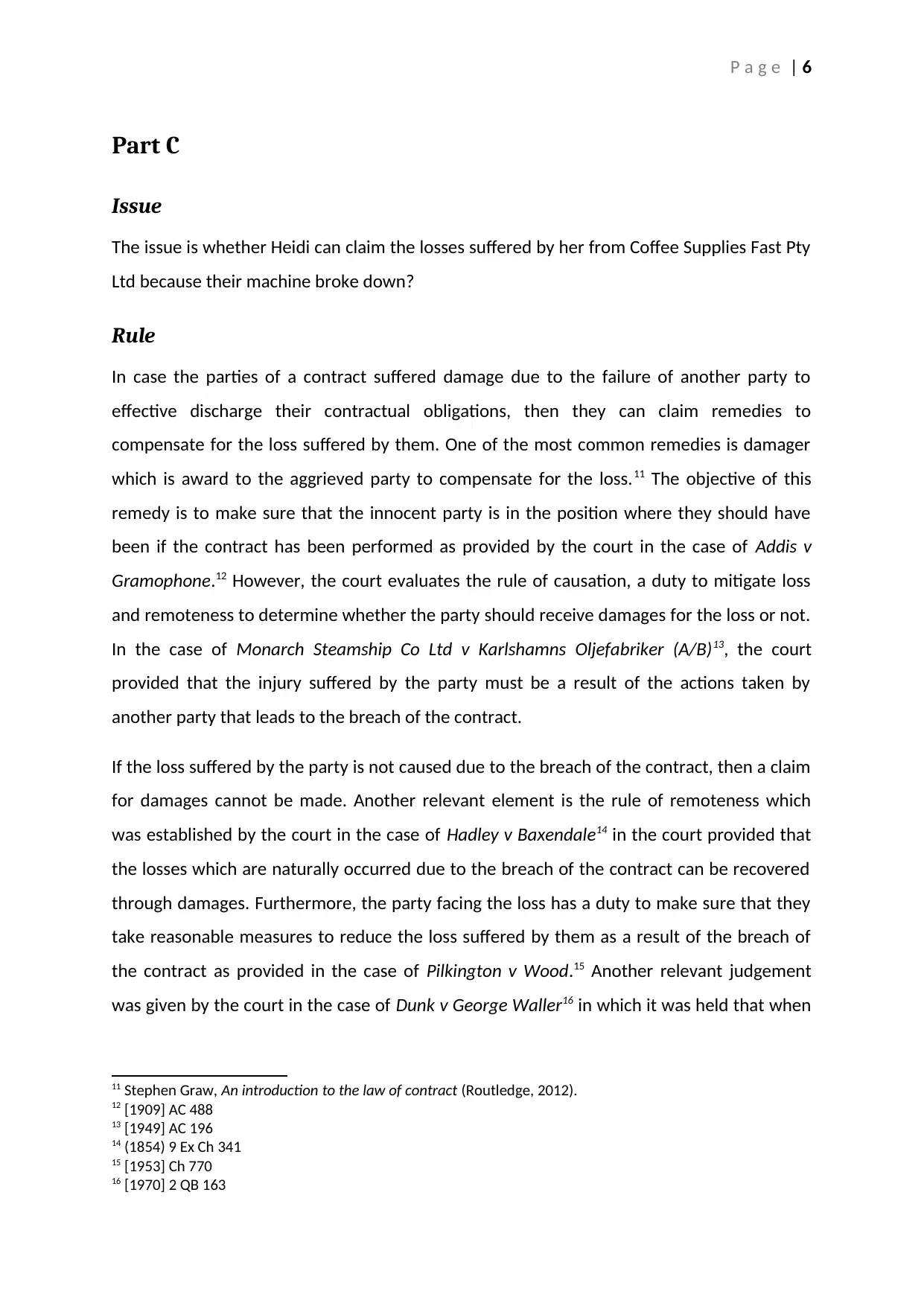
P a g e | 6
Part C
Issue
The issue is whether Heidi can claim the losses suffered by her from Coffee Supplies Fast Pty
Ltd because their machine broke down?
Rule
In case the parties of a contract suffered damage due to the failure of another party to
effective discharge their contractual obligations, then they can claim remedies to
compensate for the loss suffered by them. One of the most common remedies is damager
which is award to the aggrieved party to compensate for the loss.11 The objective of this
remedy is to make sure that the innocent party is in the position where they should have
been if the contract has been performed as provided by the court in the case of Addis v
Gramophone.12 However, the court evaluates the rule of causation, a duty to mitigate loss
and remoteness to determine whether the party should receive damages for the loss or not.
In the case of Monarch Steamship Co Ltd v Karlshamns Oljefabriker (A/B)13, the court
provided that the injury suffered by the party must be a result of the actions taken by
another party that leads to the breach of the contract.
If the loss suffered by the party is not caused due to the breach of the contract, then a claim
for damages cannot be made. Another relevant element is the rule of remoteness which
was established by the court in the case of Hadley v Baxendale14 in the court provided that
the losses which are naturally occurred due to the breach of the contract can be recovered
through damages. Furthermore, the party facing the loss has a duty to make sure that they
take reasonable measures to reduce the loss suffered by them as a result of the breach of
the contract as provided in the case of Pilkington v Wood.15 Another relevant judgement
was given by the court in the case of Dunk v George Waller16 in which it was held that when
11 Stephen Graw, An introduction to the law of contract (Routledge, 2012).
12 [1909] AC 488
13 [1949] AC 196
14 (1854) 9 Ex Ch 341
15 [1953] Ch 770
16 [1970] 2 QB 163
Part C
Issue
The issue is whether Heidi can claim the losses suffered by her from Coffee Supplies Fast Pty
Ltd because their machine broke down?
Rule
In case the parties of a contract suffered damage due to the failure of another party to
effective discharge their contractual obligations, then they can claim remedies to
compensate for the loss suffered by them. One of the most common remedies is damager
which is award to the aggrieved party to compensate for the loss.11 The objective of this
remedy is to make sure that the innocent party is in the position where they should have
been if the contract has been performed as provided by the court in the case of Addis v
Gramophone.12 However, the court evaluates the rule of causation, a duty to mitigate loss
and remoteness to determine whether the party should receive damages for the loss or not.
In the case of Monarch Steamship Co Ltd v Karlshamns Oljefabriker (A/B)13, the court
provided that the injury suffered by the party must be a result of the actions taken by
another party that leads to the breach of the contract.
If the loss suffered by the party is not caused due to the breach of the contract, then a claim
for damages cannot be made. Another relevant element is the rule of remoteness which
was established by the court in the case of Hadley v Baxendale14 in the court provided that
the losses which are naturally occurred due to the breach of the contract can be recovered
through damages. Furthermore, the party facing the loss has a duty to make sure that they
take reasonable measures to reduce the loss suffered by them as a result of the breach of
the contract as provided in the case of Pilkington v Wood.15 Another relevant judgement
was given by the court in the case of Dunk v George Waller16 in which it was held that when
11 Stephen Graw, An introduction to the law of contract (Routledge, 2012).
12 [1909] AC 488
13 [1949] AC 196
14 (1854) 9 Ex Ch 341
15 [1953] Ch 770
16 [1970] 2 QB 163
Paraphrase This Document
Need a fresh take? Get an instant paraphrase of this document with our AI Paraphraser
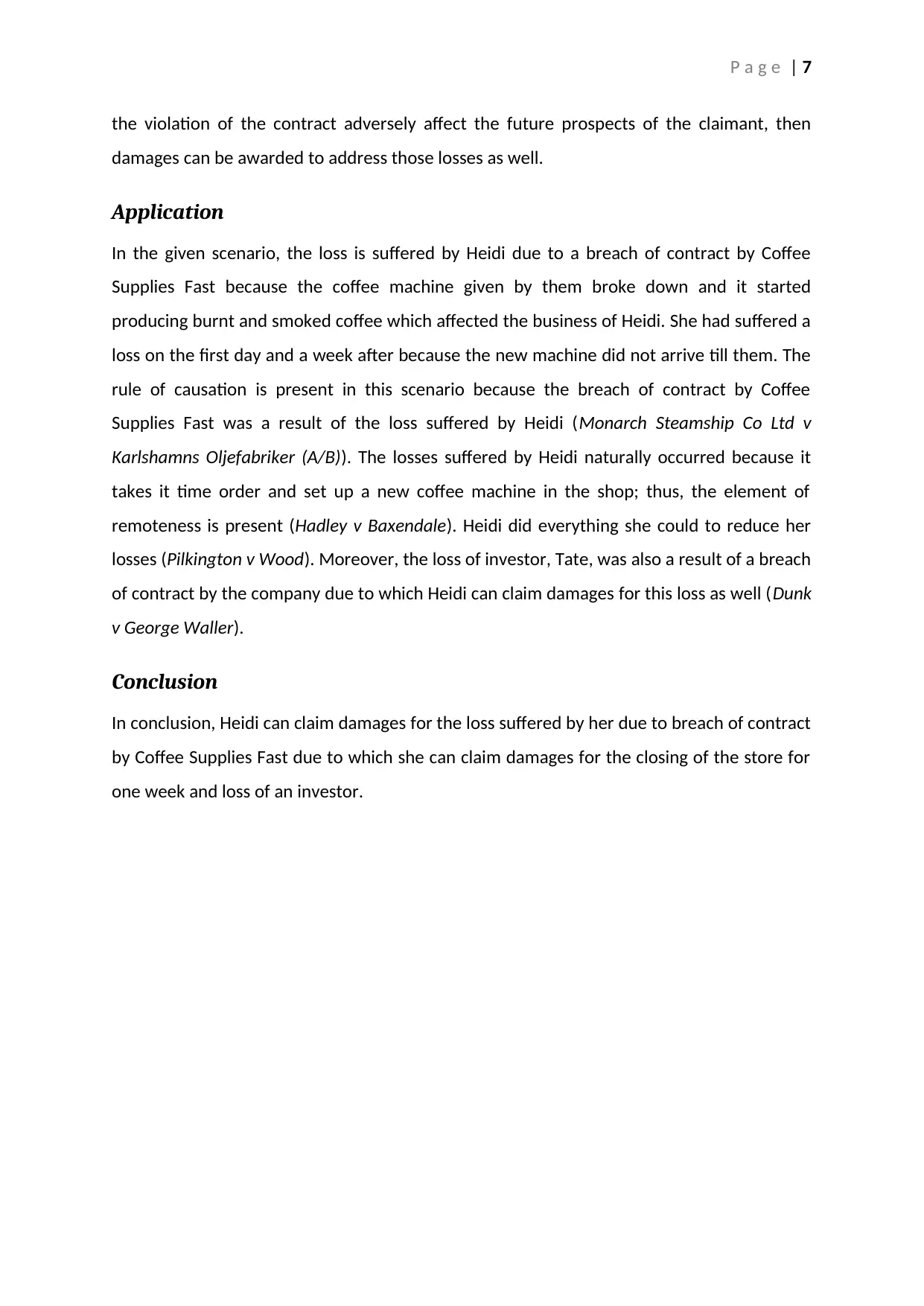
P a g e | 7
the violation of the contract adversely affect the future prospects of the claimant, then
damages can be awarded to address those losses as well.
Application
In the given scenario, the loss is suffered by Heidi due to a breach of contract by Coffee
Supplies Fast because the coffee machine given by them broke down and it started
producing burnt and smoked coffee which affected the business of Heidi. She had suffered a
loss on the first day and a week after because the new machine did not arrive till them. The
rule of causation is present in this scenario because the breach of contract by Coffee
Supplies Fast was a result of the loss suffered by Heidi (Monarch Steamship Co Ltd v
Karlshamns Oljefabriker (A/B)). The losses suffered by Heidi naturally occurred because it
takes it time order and set up a new coffee machine in the shop; thus, the element of
remoteness is present (Hadley v Baxendale). Heidi did everything she could to reduce her
losses (Pilkington v Wood). Moreover, the loss of investor, Tate, was also a result of a breach
of contract by the company due to which Heidi can claim damages for this loss as well (Dunk
v George Waller).
Conclusion
In conclusion, Heidi can claim damages for the loss suffered by her due to breach of contract
by Coffee Supplies Fast due to which she can claim damages for the closing of the store for
one week and loss of an investor.
the violation of the contract adversely affect the future prospects of the claimant, then
damages can be awarded to address those losses as well.
Application
In the given scenario, the loss is suffered by Heidi due to a breach of contract by Coffee
Supplies Fast because the coffee machine given by them broke down and it started
producing burnt and smoked coffee which affected the business of Heidi. She had suffered a
loss on the first day and a week after because the new machine did not arrive till them. The
rule of causation is present in this scenario because the breach of contract by Coffee
Supplies Fast was a result of the loss suffered by Heidi (Monarch Steamship Co Ltd v
Karlshamns Oljefabriker (A/B)). The losses suffered by Heidi naturally occurred because it
takes it time order and set up a new coffee machine in the shop; thus, the element of
remoteness is present (Hadley v Baxendale). Heidi did everything she could to reduce her
losses (Pilkington v Wood). Moreover, the loss of investor, Tate, was also a result of a breach
of contract by the company due to which Heidi can claim damages for this loss as well (Dunk
v George Waller).
Conclusion
In conclusion, Heidi can claim damages for the loss suffered by her due to breach of contract
by Coffee Supplies Fast due to which she can claim damages for the closing of the store for
one week and loss of an investor.
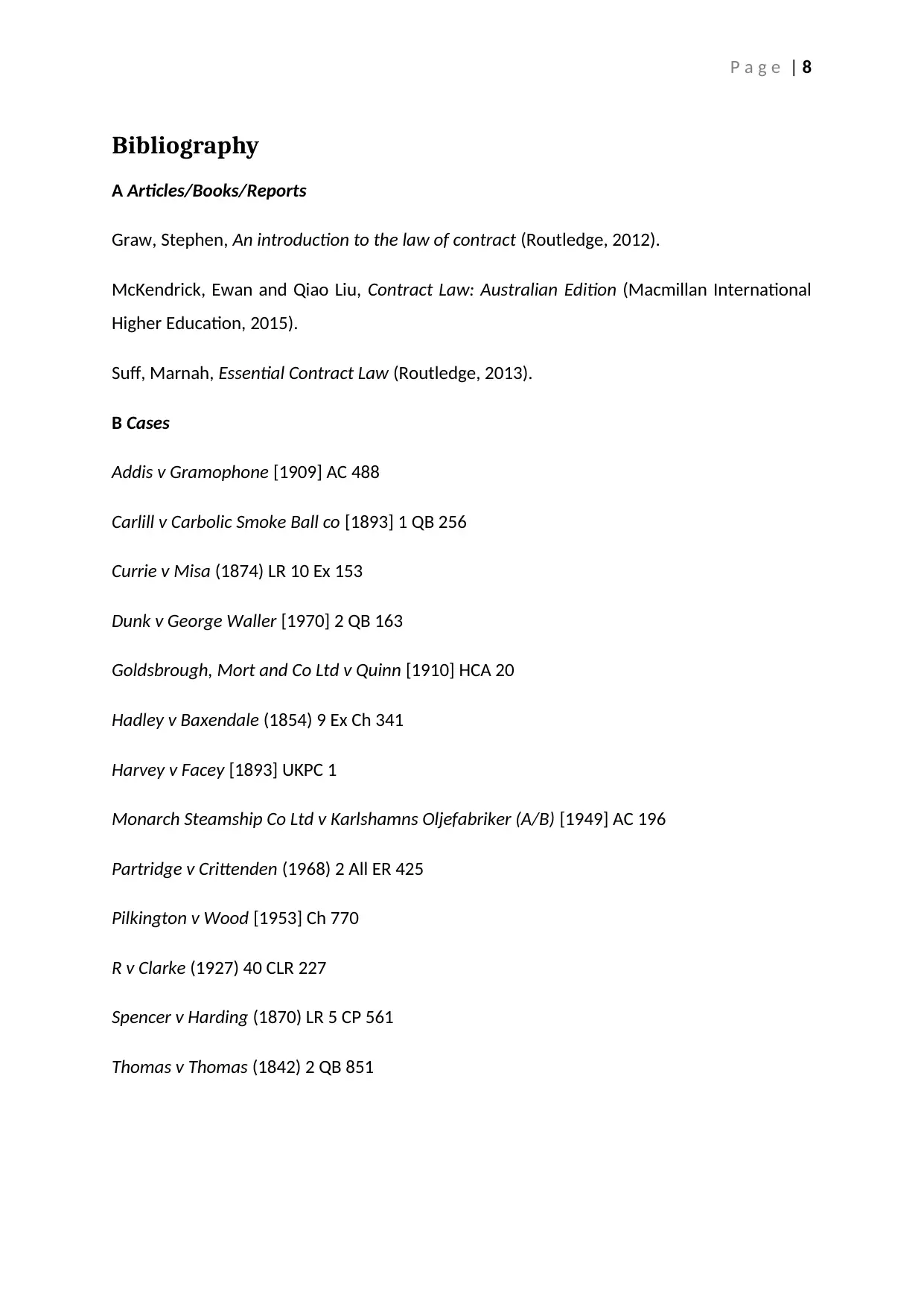
P a g e | 8
Bibliography
A Articles/Books/Reports
Graw, Stephen, An introduction to the law of contract (Routledge, 2012).
McKendrick, Ewan and Qiao Liu, Contract Law: Australian Edition (Macmillan International
Higher Education, 2015).
Suff, Marnah, Essential Contract Law (Routledge, 2013).
B Cases
Addis v Gramophone [1909] AC 488
Carlill v Carbolic Smoke Ball co [1893] 1 QB 256
Currie v Misa (1874) LR 10 Ex 153
Dunk v George Waller [1970] 2 QB 163
Goldsbrough, Mort and Co Ltd v Quinn [1910] HCA 20
Hadley v Baxendale (1854) 9 Ex Ch 341
Harvey v Facey [1893] UKPC 1
Monarch Steamship Co Ltd v Karlshamns Oljefabriker (A/B) [1949] AC 196
Partridge v Crittenden (1968) 2 All ER 425
Pilkington v Wood [1953] Ch 770
R v Clarke (1927) 40 CLR 227
Spencer v Harding (1870) LR 5 CP 561
Thomas v Thomas (1842) 2 QB 851
Bibliography
A Articles/Books/Reports
Graw, Stephen, An introduction to the law of contract (Routledge, 2012).
McKendrick, Ewan and Qiao Liu, Contract Law: Australian Edition (Macmillan International
Higher Education, 2015).
Suff, Marnah, Essential Contract Law (Routledge, 2013).
B Cases
Addis v Gramophone [1909] AC 488
Carlill v Carbolic Smoke Ball co [1893] 1 QB 256
Currie v Misa (1874) LR 10 Ex 153
Dunk v George Waller [1970] 2 QB 163
Goldsbrough, Mort and Co Ltd v Quinn [1910] HCA 20
Hadley v Baxendale (1854) 9 Ex Ch 341
Harvey v Facey [1893] UKPC 1
Monarch Steamship Co Ltd v Karlshamns Oljefabriker (A/B) [1949] AC 196
Partridge v Crittenden (1968) 2 All ER 425
Pilkington v Wood [1953] Ch 770
R v Clarke (1927) 40 CLR 227
Spencer v Harding (1870) LR 5 CP 561
Thomas v Thomas (1842) 2 QB 851
1 out of 9
Your All-in-One AI-Powered Toolkit for Academic Success.
+13062052269
info@desklib.com
Available 24*7 on WhatsApp / Email
![[object Object]](/_next/static/media/star-bottom.7253800d.svg)
Unlock your academic potential
© 2024 | Zucol Services PVT LTD | All rights reserved.




